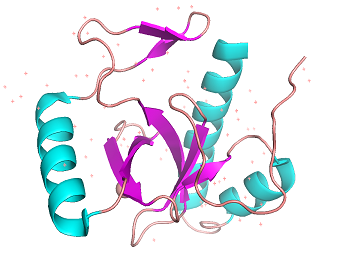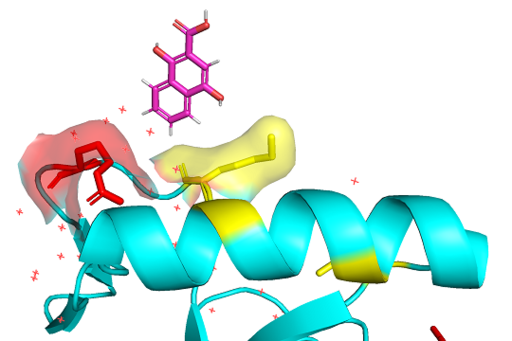Sandbox Reserved 897
From Proteopedia
(Difference between revisions)
| Line 5: | Line 5: | ||
== Overview == | == Overview == | ||
The PWWP domain belongs to the Royal family, which consists of Tudor, chromodomain, MBT(Malignant Brain Tumor), and PWWP domains. The PWWP domain was first identified as a structural motif includes 100 to 130 amino acids in WHSC1 protein research. The researchers named after its very conservative sequence, Pro-Trp-Trp-Pro located at the β2 strand of protein.<ref>Rona GB, Eleutherio EC, Pinheiro AS. PWWP domains and their modes of sensing DNA and histone methylated lysines. Biophysical reviews. 2016 Mar 1;8(1):63-74.</ref> This domain is mainly related to the recognition of methylated histone tail lysine and related to the epigenetic regulation of genes. BRPF1 PWWP domain, which has very similar structure with 3pfs, presents on actively transcribing cells and may regulate Hox A9 gene which is related to MOZ-TIF2-dependant leukemia.<ref>Vezzoli A, Bonadies N, Allen MD, Freund SM, Santiveri CM, Kvinlaug BT, Huntly BJ, Göttgens B, Bycroft M. Molecular basis of histone H3K36me3 recognition by the PWWP domain of Brpf1. Nature structural & molecular biology. 2010 May;17(5):617-9.</ref> The 3pfs motif is relatively mystery we may assume that 3pfs also do similar works | The PWWP domain belongs to the Royal family, which consists of Tudor, chromodomain, MBT(Malignant Brain Tumor), and PWWP domains. The PWWP domain was first identified as a structural motif includes 100 to 130 amino acids in WHSC1 protein research. The researchers named after its very conservative sequence, Pro-Trp-Trp-Pro located at the β2 strand of protein.<ref>Rona GB, Eleutherio EC, Pinheiro AS. PWWP domains and their modes of sensing DNA and histone methylated lysines. Biophysical reviews. 2016 Mar 1;8(1):63-74.</ref> This domain is mainly related to the recognition of methylated histone tail lysine and related to the epigenetic regulation of genes. BRPF1 PWWP domain, which has very similar structure with 3pfs, presents on actively transcribing cells and may regulate Hox A9 gene which is related to MOZ-TIF2-dependant leukemia.<ref>Vezzoli A, Bonadies N, Allen MD, Freund SM, Santiveri CM, Kvinlaug BT, Huntly BJ, Göttgens B, Bycroft M. Molecular basis of histone H3K36me3 recognition by the PWWP domain of Brpf1. Nature structural & molecular biology. 2010 May;17(5):617-9.</ref> The 3pfs motif is relatively mystery we may assume that 3pfs also do similar works | ||
| + | |||
| + | == Structure == | ||
| + | Two disticntive The first proline affects the stability and aggregation of the protein. The proline gives more stability and oligomerization to the protein, compared to the alanine at the same position.<ref>Hung YL, Lee HJ, Jiang I, Lin SC, Lo WC, Lin YJ, Sue SC. The first residue of the PWWP motif modulates HATH domain binding, Stability, and Protein–Protein Interaction. Biochemistry. 2015 Jul 7;54(26):4063-74.</ref> It has two distinctive substructural motifs: β-barrel at the N-terminal region and helixes at C-terminal region.<ref>Rona GB, Eleutherio EC, Pinheiro AS. PWWP domains and their modes of sensing DNA and histone methylated lysines. Biophysical reviews. 2016 Mar 1;8(1):63-74.</ref> The β-barrel is a very conservative feature of PWWP domains and it is composed of 5 β-strands. 3pfs has 3 helixes which are little more than many of its relatives. The stability of domain comes from both inter-substructure and intra-substructure interactions including hydrogen bonds and polar interactions. | ||
| + | [[Image:3pfs cartoon.png|thumb|center|512 px| '''Figure 1:''' Cartoon model of 3PFS motif. β-sheets(magenta) and helixes(orange) are shown. generated in PyMOL using PDB: ''3PFS'']] | ||
== Function == | == Function == | ||
| - | The PWWP domain is also used for protein-protein interaction. This domain also may have nonspecific interaction with a DNA strand, using its abundant lysine and arginine residues. | ||
===Nonspecific binding=== | ===Nonspecific binding=== | ||
The PWWP domains have a significant amount of basic residues.<ref>Qiu C, Sawada K, Zhang X, Cheng X. The PWWP domain of mammalian DNA methyltransferase Dnmt3b defines a new family of DNA-binding folds. Nature structural biology. 2002 Mar;9(3):217-24.</ref> 3pfs also has 11 lysine residues and 12 arginine residues. These residues' sidechains would be positively charged on in vivo pH. The DNA strand phosphate backbone, which is negatively charged, is attracted to PWWP domain surface due to the nature of attraction between the opposite charges. | The PWWP domains have a significant amount of basic residues.<ref>Qiu C, Sawada K, Zhang X, Cheng X. The PWWP domain of mammalian DNA methyltransferase Dnmt3b defines a new family of DNA-binding folds. Nature structural biology. 2002 Mar;9(3):217-24.</ref> 3pfs also has 11 lysine residues and 12 arginine residues. These residues' sidechains would be positively charged on in vivo pH. The DNA strand phosphate backbone, which is negatively charged, is attracted to PWWP domain surface due to the nature of attraction between the opposite charges. | ||
| - | + | ||
| - | [[Image:3pfs non-selective model.png|thumb|center|512 px| '''Figure | + | [[Image:3pfs non-selective model.png|thumb|center|512 px| '''Figure 2:''' Lysine(yellow) and Arginine(red) residues on 3PFS surface interacting with DNA backbone generated in PyMOL using PDB: ''3PFS'']] |
===Methyl-lysine reader=== | ===Methyl-lysine reader=== | ||
PWWP domains are one of epigenetic regulators which recognize specific lysine residues which are methylated. Even though there is no detailed research on 3pfs, it is assumed to have similar function with BRPF1 PWWP domain which is shown to have methylated histone binding activity.<ref>Vezzoli A, Bonadies N, Allen MD, Freund SM, Santiveri CM, Kvinlaug BT, Huntly BJ, Göttgens B, Bycroft M. Molecular basis of histone H3K36me3 recognition by the PWWP domain of Brpf1. Nature structural & molecular biology. 2010 May;17(5):617-9.</ref> With a high-throughput mass spectrometry screening, this motif is suggested as an essential motif of histone 3 lysine 36 trimethylation binding.<ref>Vermeulen M, Eberl HC, Matarese F, Marks H, Denissov S, Butter F, Lee KK, Olsen JV, Hyman AA, Stunnenberg HG, Mann M. Quantitative interaction proteomics and genome-wide profiling of epigenetic histone marks and their readers. Cell. 2010 Sep 17;142(6):967-80.</ref> The β-strands and Pro-Trp-Trp-Pro motif form hydrophobic cavity, which is the binding site of methylated lysines.<ref>Rona GB, Eleutherio EC, Pinheiro AS. PWWP domains and their modes of sensing DNA and histone methylated lysines. Biophysical reviews. 2016 Mar 1;8(1):63-74.</ref> Since the aromatic cage is a common structure in the Royal family, it can be a common tool for methylated lysine binding.<ref>Qiu Y, Zhang W, Zhao C, Wang Y, Wang W, Zhang J, Zhang Z, Li G, Shi Y, Tu X, Wu J. Solution structure of the Pdp1 PWWP domain reveals its unique binding sites for methylated H4K20 and DNA. Biochemical Journal. 2012 Mar 15;442(3):527-38.</ref> | PWWP domains are one of epigenetic regulators which recognize specific lysine residues which are methylated. Even though there is no detailed research on 3pfs, it is assumed to have similar function with BRPF1 PWWP domain which is shown to have methylated histone binding activity.<ref>Vezzoli A, Bonadies N, Allen MD, Freund SM, Santiveri CM, Kvinlaug BT, Huntly BJ, Göttgens B, Bycroft M. Molecular basis of histone H3K36me3 recognition by the PWWP domain of Brpf1. Nature structural & molecular biology. 2010 May;17(5):617-9.</ref> With a high-throughput mass spectrometry screening, this motif is suggested as an essential motif of histone 3 lysine 36 trimethylation binding.<ref>Vermeulen M, Eberl HC, Matarese F, Marks H, Denissov S, Butter F, Lee KK, Olsen JV, Hyman AA, Stunnenberg HG, Mann M. Quantitative interaction proteomics and genome-wide profiling of epigenetic histone marks and their readers. Cell. 2010 Sep 17;142(6):967-80.</ref> The β-strands and Pro-Trp-Trp-Pro motif form hydrophobic cavity, which is the binding site of methylated lysines.<ref>Rona GB, Eleutherio EC, Pinheiro AS. PWWP domains and their modes of sensing DNA and histone methylated lysines. Biophysical reviews. 2016 Mar 1;8(1):63-74.</ref> Since the aromatic cage is a common structure in the Royal family, it can be a common tool for methylated lysine binding.<ref>Qiu Y, Zhang W, Zhao C, Wang Y, Wang W, Zhang J, Zhang Z, Li G, Shi Y, Tu X, Wu J. Solution structure of the Pdp1 PWWP domain reveals its unique binding sites for methylated H4K20 and DNA. Biochemical Journal. 2012 Mar 15;442(3):527-38.</ref> | ||
| - | == Structure == | ||
| - | Two disticntive The first proline affects the stability and aggregation of the protein. The proline gives more stability and oligomerization to the protein, compared to the alanine at the same position.<ref>Hung YL, Lee HJ, Jiang I, Lin SC, Lo WC, Lin YJ, Sue SC. The first residue of the PWWP motif modulates HATH domain binding, Stability, and Protein–Protein Interaction. Biochemistry. 2015 Jul 7;54(26):4063-74.</ref> It has two distinctive substructural motifs: β-barrel at the N-terminal region and helixes at C-terminal region.<ref>Rona GB, Eleutherio EC, Pinheiro AS. PWWP domains and their modes of sensing DNA and histone methylated lysines. Biophysical reviews. 2016 Mar 1;8(1):63-74.</ref> The β-barrel is a very conservative feature of PWWP domains and it is composed of 5 β-strands. 3pfs has 3 helixes which are little more than many of its relatives. The stability of domain comes from both inter-substructure and intra-substructure interactions including hydrogen bonds and polar interactions. | ||
=== Evolutionary conservations === | === Evolutionary conservations === | ||
Revision as of 18:11, 28 April 2020
| This Sandbox is Reserved from Jan 13 through July 31, 2020 for use in the course Protein Structure in Drug Discovery taught by Karen C. Glass at the ACPHS, Colchester, United States. This reservation includes Sandbox Reserved 895 through Sandbox Reserved 901. |
To get started:
More help: Help:Editing |
BRPF3 PWWP binding domain 3PFS
| |||||||||||
References
- ↑ Rona GB, Eleutherio EC, Pinheiro AS. PWWP domains and their modes of sensing DNA and histone methylated lysines. Biophysical reviews. 2016 Mar 1;8(1):63-74.
- ↑ Vezzoli A, Bonadies N, Allen MD, Freund SM, Santiveri CM, Kvinlaug BT, Huntly BJ, Göttgens B, Bycroft M. Molecular basis of histone H3K36me3 recognition by the PWWP domain of Brpf1. Nature structural & molecular biology. 2010 May;17(5):617-9.
- ↑ Hung YL, Lee HJ, Jiang I, Lin SC, Lo WC, Lin YJ, Sue SC. The first residue of the PWWP motif modulates HATH domain binding, Stability, and Protein–Protein Interaction. Biochemistry. 2015 Jul 7;54(26):4063-74.
- ↑ Rona GB, Eleutherio EC, Pinheiro AS. PWWP domains and their modes of sensing DNA and histone methylated lysines. Biophysical reviews. 2016 Mar 1;8(1):63-74.
- ↑ Qiu C, Sawada K, Zhang X, Cheng X. The PWWP domain of mammalian DNA methyltransferase Dnmt3b defines a new family of DNA-binding folds. Nature structural biology. 2002 Mar;9(3):217-24.
- ↑ Vezzoli A, Bonadies N, Allen MD, Freund SM, Santiveri CM, Kvinlaug BT, Huntly BJ, Göttgens B, Bycroft M. Molecular basis of histone H3K36me3 recognition by the PWWP domain of Brpf1. Nature structural & molecular biology. 2010 May;17(5):617-9.
- ↑ Vermeulen M, Eberl HC, Matarese F, Marks H, Denissov S, Butter F, Lee KK, Olsen JV, Hyman AA, Stunnenberg HG, Mann M. Quantitative interaction proteomics and genome-wide profiling of epigenetic histone marks and their readers. Cell. 2010 Sep 17;142(6):967-80.
- ↑ Rona GB, Eleutherio EC, Pinheiro AS. PWWP domains and their modes of sensing DNA and histone methylated lysines. Biophysical reviews. 2016 Mar 1;8(1):63-74.
- ↑ Qiu Y, Zhang W, Zhao C, Wang Y, Wang W, Zhang J, Zhang Z, Li G, Shi Y, Tu X, Wu J. Solution structure of the Pdp1 PWWP domain reveals its unique binding sites for methylated H4K20 and DNA. Biochemical Journal. 2012 Mar 15;442(3):527-38.
- ↑ Rona GB, Eleutherio EC, Pinheiro AS. PWWP domains and their modes of sensing DNA and histone methylated lysines. Biophysical reviews. 2016 Mar 1;8(1):63-74.
- ↑ Bjarkam CR, Corydon TJ, Olsen IM, Pallesen J, Nyegaard M, Fryland T, Mors O, Børglum AD. Further immunohistochemical characterization of BRD1 a new susceptibility gene for schizophrenia and bipolar affective disorder. Brain Structure and Function. 2009 Dec 1;214(1):37.


